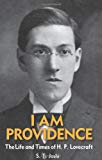
I Am Providence: The Life and Times of H. P. Lovecraft (2 VOLUMES) PDF
Preview I Am Providence: The Life and Times of H. P. Lovecraft (2 VOLUMES)
S. T. Joshi s award-winning biography H. P. Lovecraft: A Life (1996) provided the most detailed portrait of the life, work, and thought of the dreamer from Providence ever published. But that edition was in fact abridged from Joshi s original manuscript, and this expanded and updated edition restores the 150,000 words that Joshi omitted and, in addition, updates the texts with new findings.
Howard Phillips Lovecraft was born to a well-to-do family in Providence, Rhode Island. As a child, he revealed remarkable precocity in his early interests in literature and science. Ill-health dogged him in youth, rendering school attendance sporadic; and in 1908 he experienced a nervous breakdown that rendered him a virtual recluse for several years. In 1914 he discovered the world of amateur journalism and began slowly emerging from his hermitry. He wrote tremendous amounts of essays, poetry, and other work; in 1917, under the encouragement from W. Paul Cook and others, he resumed the writing of horror fiction, and his career as a dream-weaver began anew.
In 1921 Lovecraft met his future wife, Sonia H. Greene, at an amateur journalism convention. It was at this time that he began expanding his horizons, both geographical and intellectual: he traveled widely, from New England to New York to Cleveland; and he absorbed such literary and intellectual influences as Lord Dunsany, Friedrich Nietzsche, and Arthur Machen. In 1924 he and Sonia decided to marry, and Lovecraft moved to New York to pursue his literary fortune. But, as the first volume of this biography concludes, his metropolitan adventure would be bittersweet at best.
As the second volume of S. T. Joshi s comprehensive biography of H. P. Lovecraft begins, we find Lovecraft dwelling in misery in a one-room apartment in Brooklyn Heights: his wife, Sonia, has had to move to the Midwest for work, and he must rely on the companionship of the Kalem Club, the informal band of friends in the New York area. In 1926, in part through the intervention of his close friend Frank Belknap Long, Lovecraft finally decided to return to his native Providence, Rhode Island, effectively ending his marriage. That return spurred the greatest spurt of literary creativity he would ever experience: in less than a year, such works as "The Call of Cthulhu," The Dream-Quest of Unknown Kadath, The Case of Charles Dexter Ward, and The Colour out of Space would emerge from his pen, establishing Lovecraft as the leading weird fictionist of his generation.
In spite of his increasing poverty, antiquarian travel occupied much of Lovecraft s time, and he gained an impressive knowledge of such oases of antiquity as Charleston, Quebec, St. Augustine, and Richmond. These voyages both renewed his connection with the past and infused his literary work, as such later tales as The Whisperer in Darkness and The Shadow over Innsmouth drew ever more profoundly upon his far-flung travels.
Intellectually, Lovecraft evolved as well. Recent developments in science confirmed his materialism and his atheism, and the onset of the Great Depression gradually caused him to reassess his political and economic theory; he emerged as a moderate socialist and advocate of the New Deal. Late in life he became a giant in the world of fantasy fandom a development that foreshadowed his worldwide fame in the decades following his early death.
**
